Globywood
The story of movie industries across time.
| Introduction |
|---|
| Selecting the data |
| Diversity analysis of actors |
| How long will I be in the theater? |
| A deeper look at movie summaries |
Exploring movie plots
Our research question is to understand how movie plots are structured and whether they differ across industries, decades, and genres. To answer this question, we created an NLP pipeline to:
- Study the words used in plots
- Compare them across different diversity attributes
- Perform semantic analysis and check for similarities
- Propose a method to extract keypoints from summaries
Bag of words
We begin by studying the words used in plot summaries and examining the general word usage across all plots.
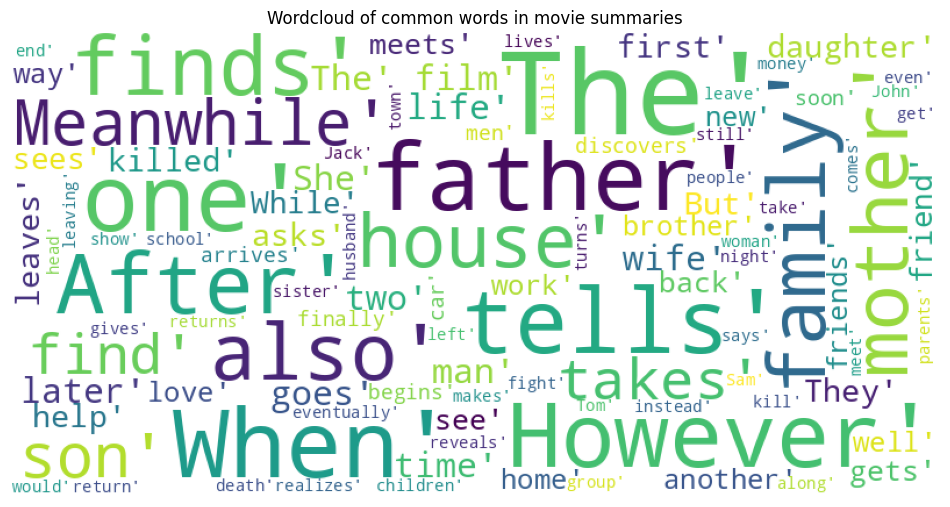
Now bring your loop and let’s search from where they are comming.
Across decades
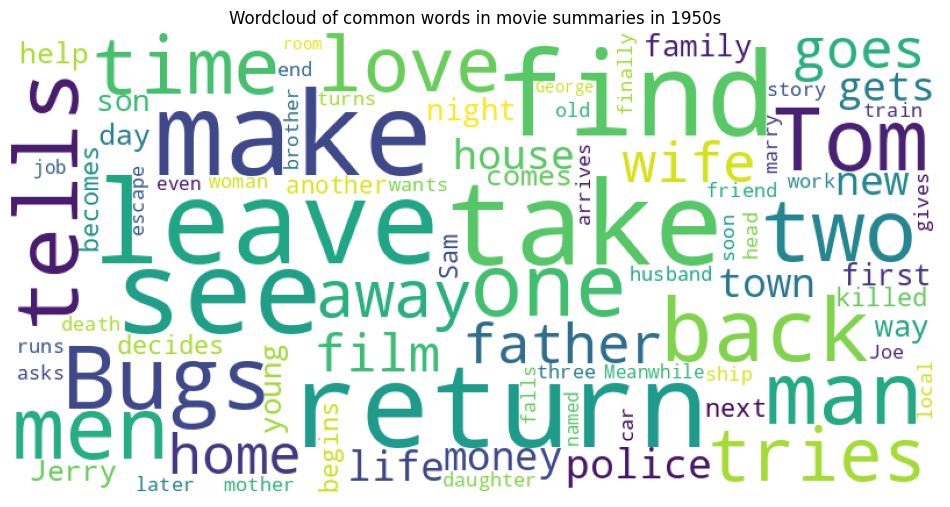
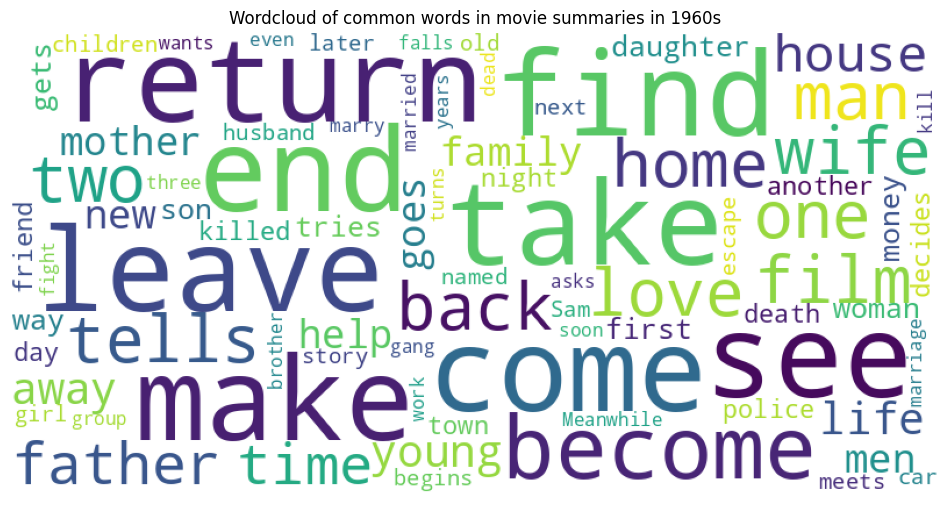
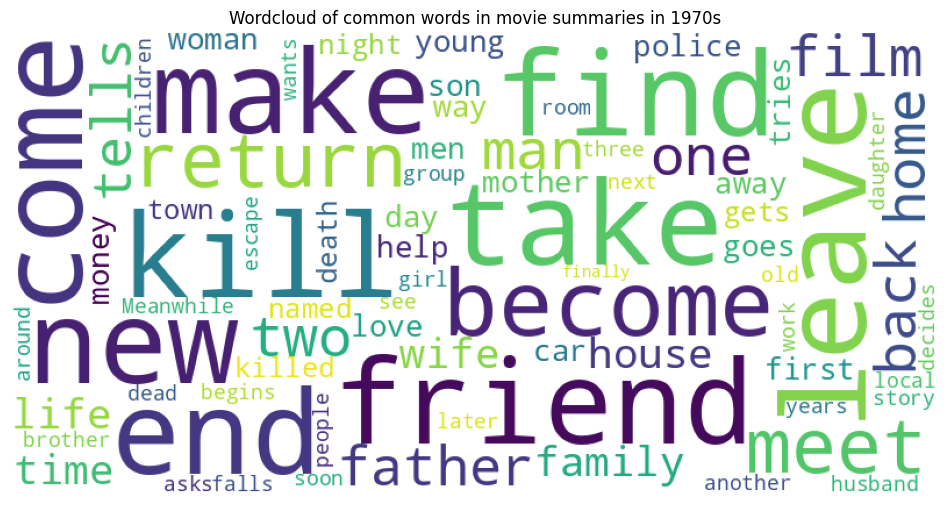
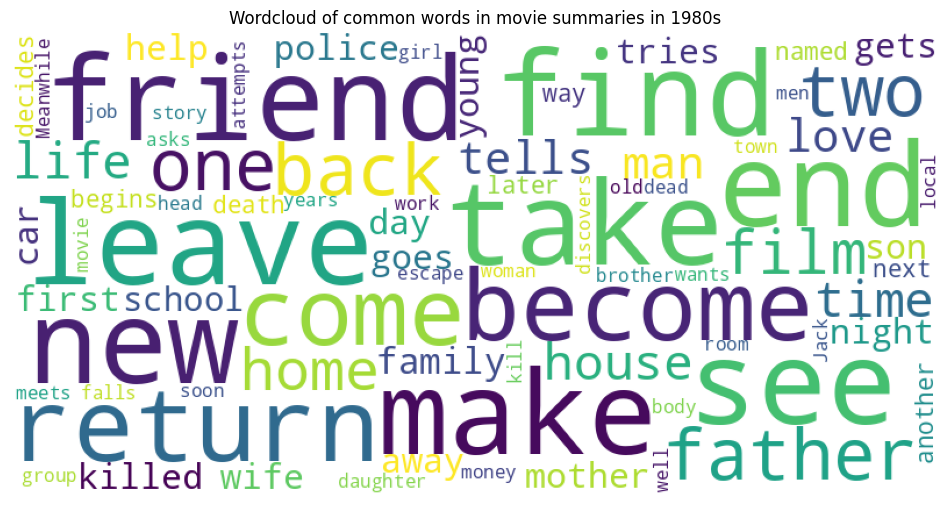
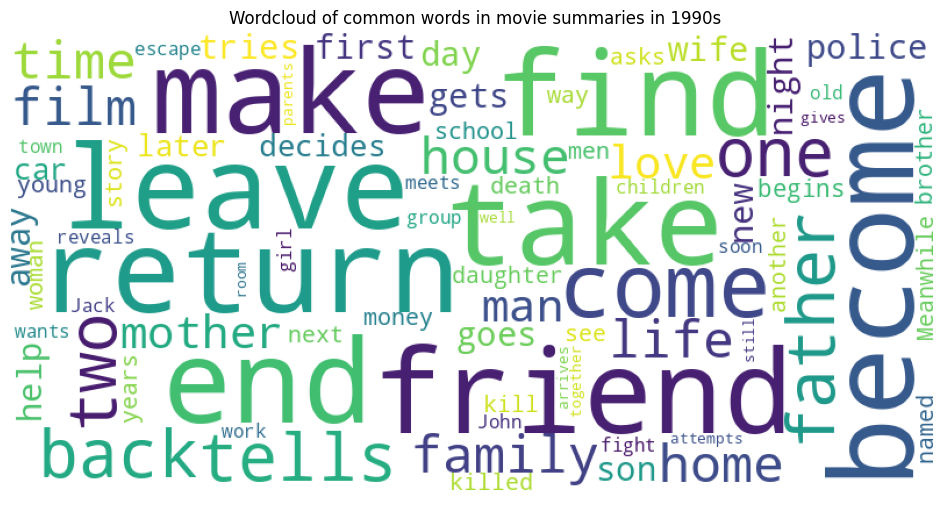
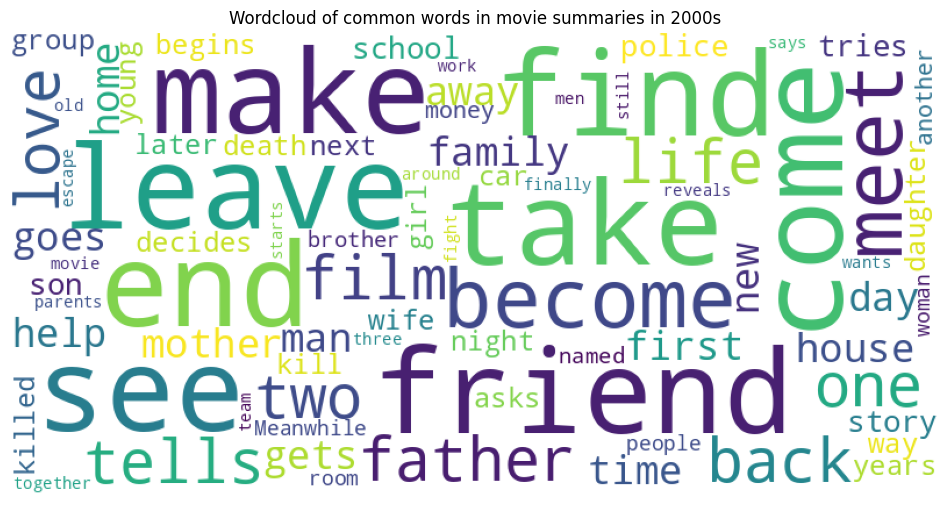
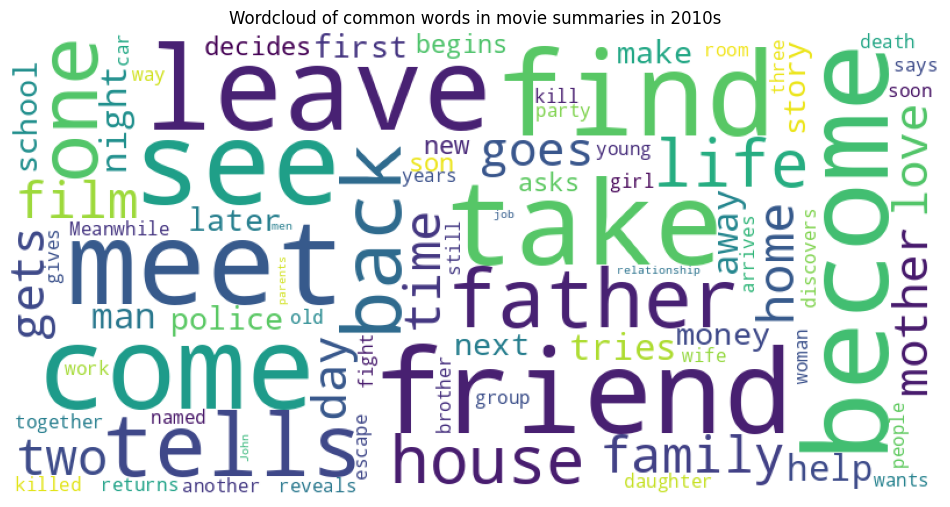
From these word clouds, we can observe that movies from the 50s, 60s, and 70s contain more action-related words such as “escape,” “kill,” and “dead,” while movies from the 2000s tend to focus more on relationships and drama. We can investigate this further by excluding articles and common empty words and plotting the standardized distributions of the top 20 words.
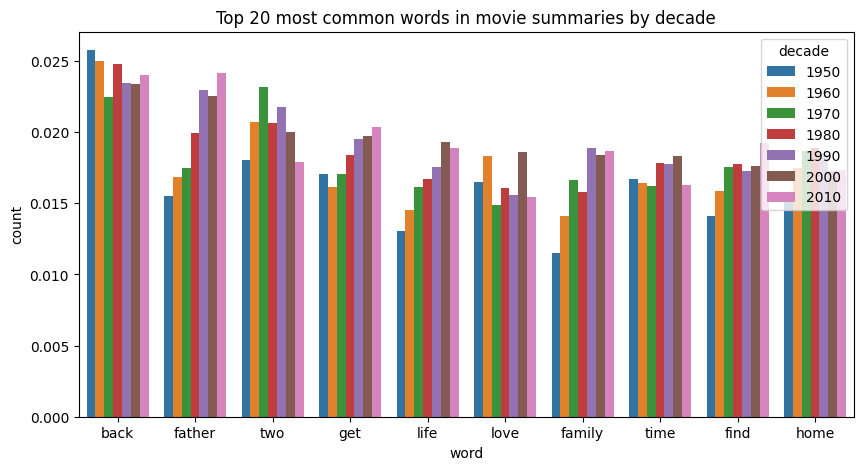
Across industries
To save space, we will directly show the distribution of the 40 most common words across industries.
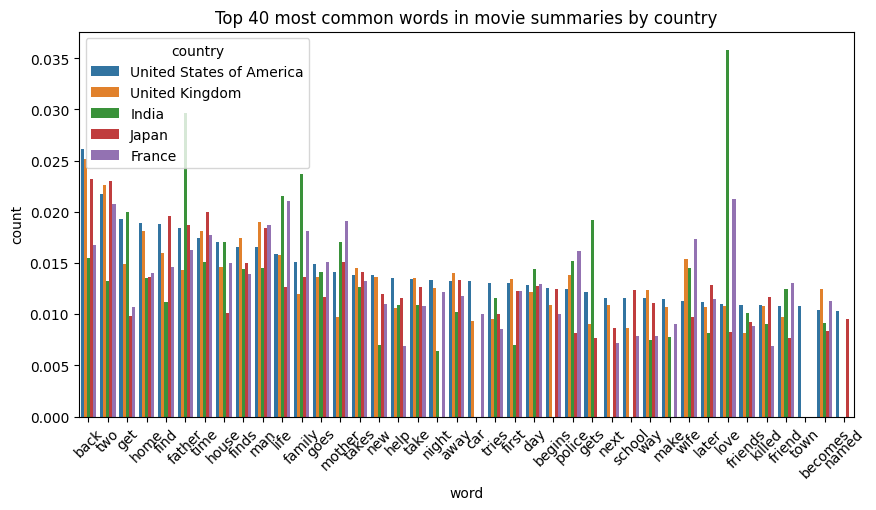 We can see that the Indian industry tends to focus on love and family relationships, resulting in a focus on drama. Meanwhile, the French industry is a mixture of drama-linked words and crime. This will be more evident when we analyze the genres.
We can see that the Indian industry tends to focus on love and family relationships, resulting in a focus on drama. Meanwhile, the French industry is a mixture of drama-linked words and crime. This will be more evident when we analyze the genres.
Across genres
Analysing the distributions of the genres, Thriller, Crime fiction and Drama were among the top 3 movie genres.
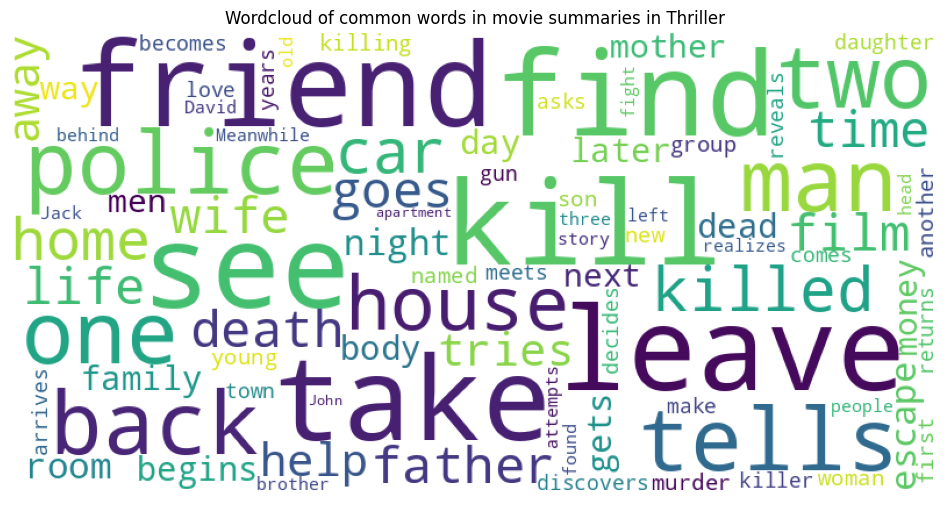
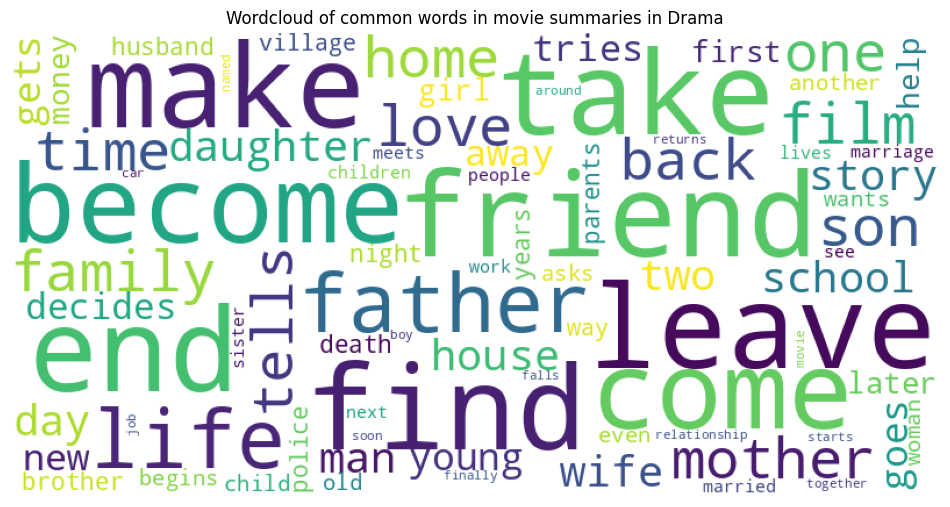

We notice that there is a lot of action based verbs/event (murder, killed, escape, leave). Now we take Us and UK and compare them for the same genre.
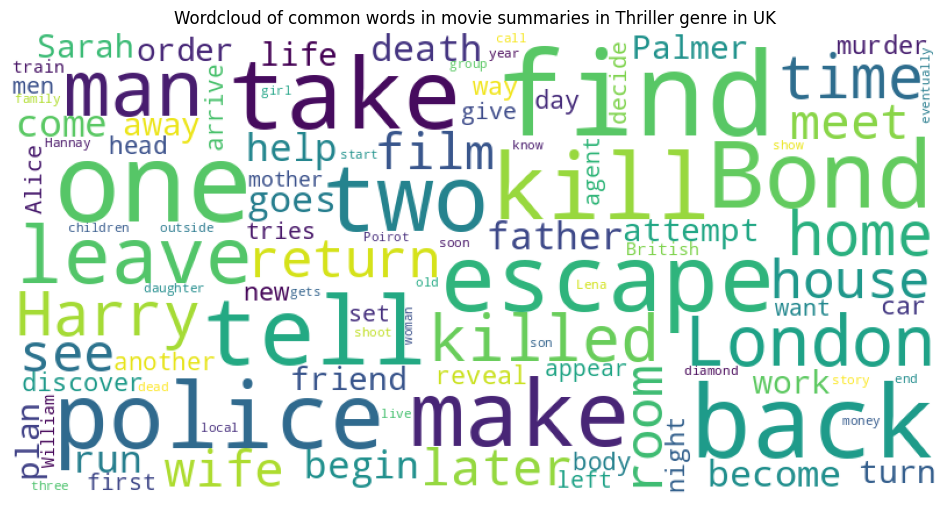
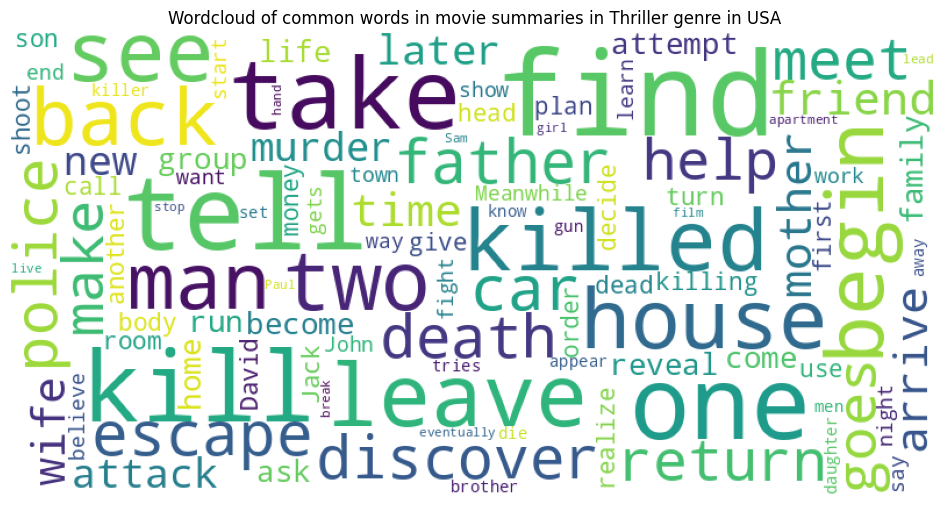
Taking 2 countries and the same genre, we notice that there is an overlap but still each have unique attributes. Highliting that the industry plays a role.
Semantic analysis
In natural language processing (NLP), semantic similarity refers to the degree to which two pieces of text or language convey the same or similar meaning. It can be used to measure the similarity of words, phrases, sentences, or entire documents.
To further understand and visualize the structures and similarities of movie plots, we will use t-SNE (t-distributed Stochastic Neighbor Embedding) to project the embeddings generated by the all-MiniLM-L6 model onto a 2D space. This will allow us to more easily interpret and analyze the semantic differences between the plots and their embeddings.
In addition to analyzing the differences across countries, genres, and decades, as we have done in our diversity study, we will use t-SNE to visualize these differences and gain further insights into the structures and patterns present in the movie plots.

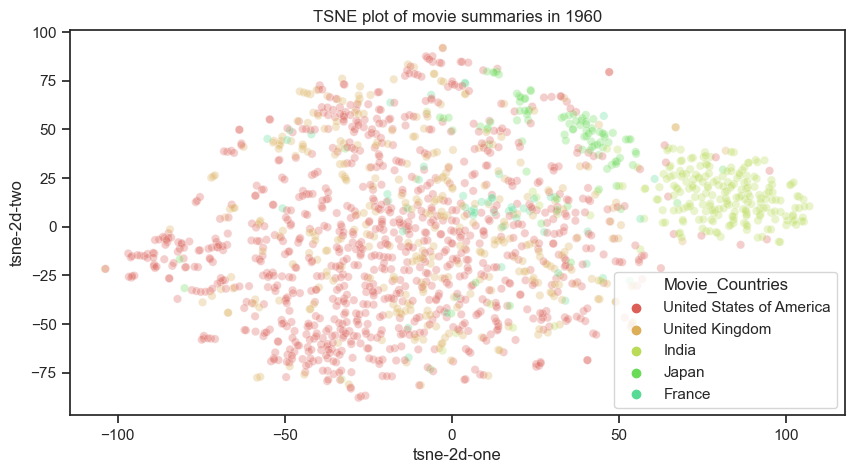
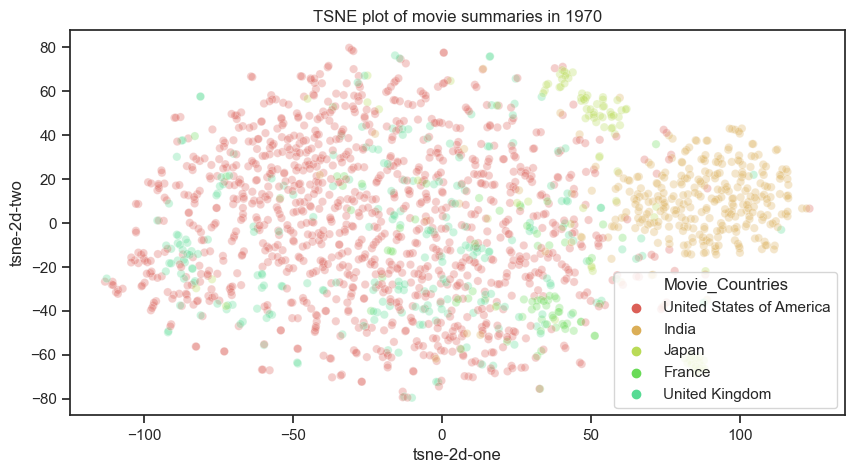
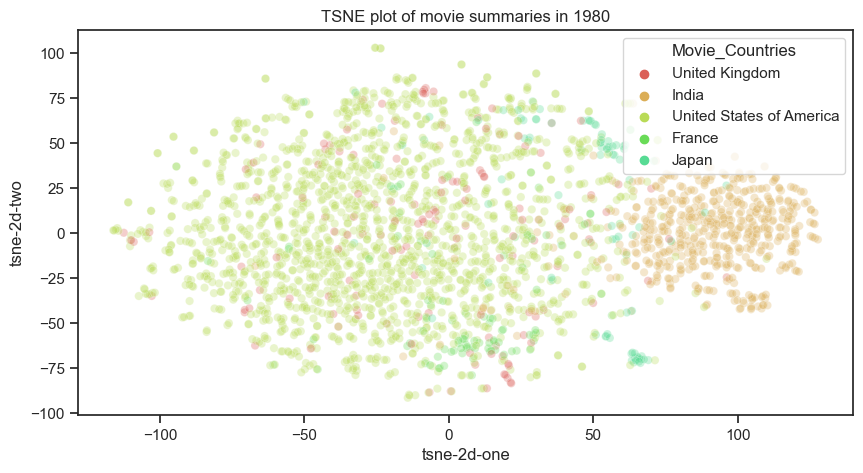
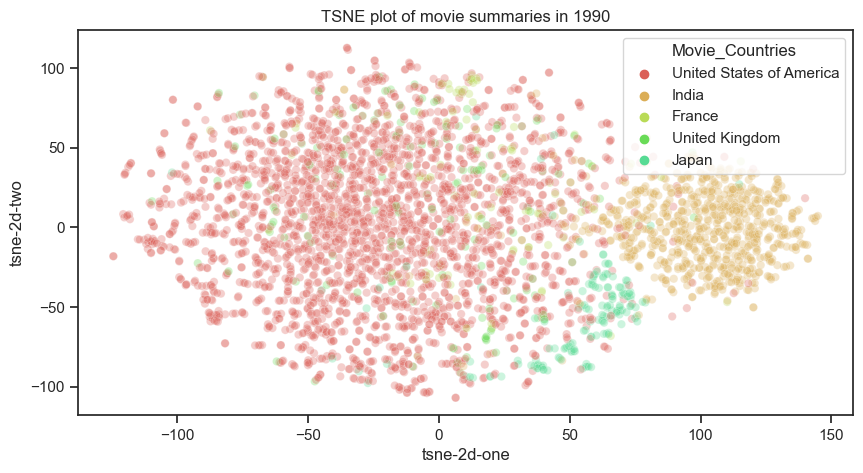
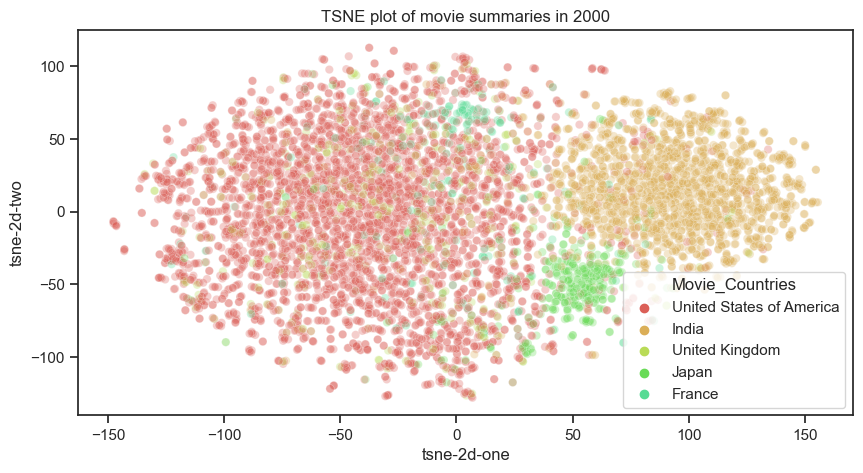
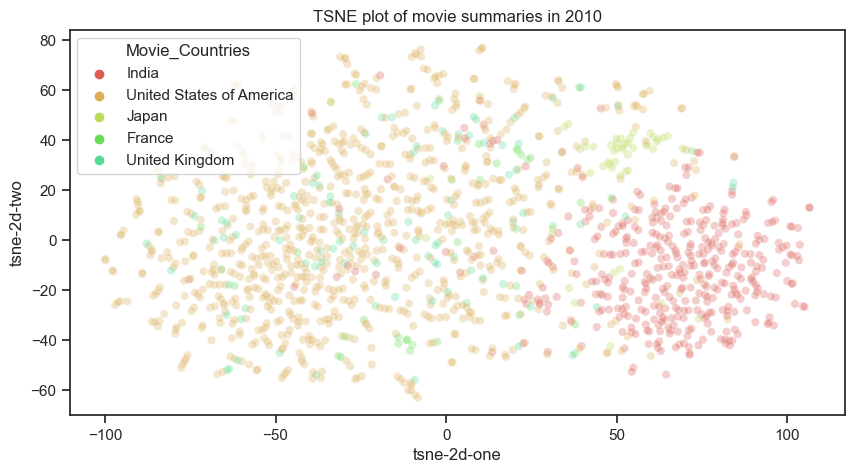
A major aspect, we notice after performing tsne, that the indian movie plots especially starting the 70s are unique to themselves whereas the western movies are similiar semantically to one another.
Doing the same across the genres for the same decade showed that sementacilly the plots have a high similarity.
We can see it for example for the case of the 2000’s
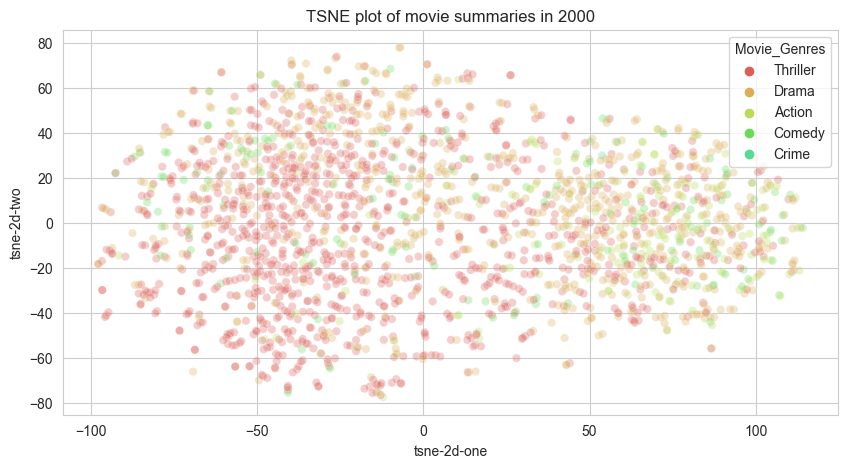
Performing the analysis across genres showed interesting results when it came to the drama genres, each industry has its own specifcations.
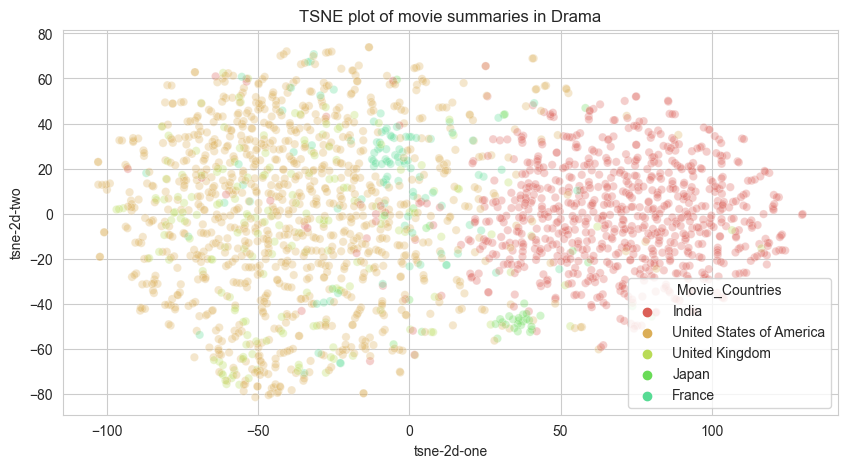
Kp extraction/ Main event
With main event, we are not referring 229 when khabib submitted conor mcgregor. Sometimes, movies can be long and summaries can be lengthy. To help you get a quick overview of the most important events, we have developed a method to extract the N most relevant events from movie plots across industries (Psss a summary of summary is always better for lazy people)
To do this, we calculate the cosine similarity matrix between the sentence embeddings of the movie plots. The sentences with the highest number of comparisons that pass a minimum threshold of 0.8 are considered candidates for keypoints. We then filter the N keypoints that passed the threshold by selecting the ones with the lowest cosine similarities between them, resulting in a set of general keypoints that provide a summary of the main events in the movie. </br>
Let’s take a plot summary
Movie: A Girl Cut in Two </br> Plot: The film revolves around two men who vie for a single young woman, Gabrielle Deneige. Gabrielle, a local weather woman, is in her twenties and lives with her mother, who works in a little bookstore. Charles Saint-Denis is a famed author who has just written a new book. Seeming to shy away from the public eye, he lives in the countryside of Lyon with his wife. At a party after a television interview about his new novel, Charles first spies young Gabrielle, then attends a book signing in the bookshop where Gabrielle’s mother works. After a little flirting, Charles gives Gabrielle a copy of his book and an invitation for her to attend an auction with him. She agrees. The local scion of a pharmaceutical company, Paul Gaudens, enters the store and confronts Saint-Denis, then sees Gabrielle. Paul invites her to dinner with him. She agrees to go. While they are at dinner, Charles meets with friends, one of whom speaks about his daughter dating a man Charles’ age, and how he handles the situation. Charles asks him about the auction on Saturday. The scene cuts to the exterior of the restaurant, where Gabrielle thanks Paul for the meal. He offers to take her home, but she indicates it isn’t far and that she’s on her scooter. Paul tells her she’s “amazing, honestly.” Gabrielle puts him off, telling him that she likes him, but not to pressure her. She walks to her motorbike and drives off. Paul shows he is unhappy at not getting what he wants. He spots a parking ticket on his car, snatches it off, and tosses it on the ground. The audience sees more and more that Paul is a spoiled rich kid with serious issues about getting what he wants. The following Saturday, Gabrielle attends the auction with Charles, where he bids on a love letter, then bids on and wins an illustrated manuscript written by an erotomaniac. He presents the document to Gabrielle, commenting that if she doesn’t like to read, she can look at the pictures. The audience will later realize this is his initial effort to let her know what his interests are. They return to Charles’ flat in the city; he pours champagne, she asks him to kiss her, and they have sex. Afterward, Gabrielle comments that she must have seemed clumsy to him. He responds, “I’ll teach you.” She observes that she probably wasn’t the first he’d brought to the flat, and he answers that she could be the last. She admires a photo on the wall, which Charles says is of Lisbon. She asks if he’ll take her there someday, then abruptly asks him the time. She realizes she is late for work and rushes to dress. Gabrielle asks Charles about meeting later that night, and he tells her, “Whoa, little girl,” and that she’s moving too fast. He says he’s not a free man, having been married for 25 years, and is 30 years older than she is. She indicates this doesn’t bother her, they quarrel, and she throws the manuscript at him and storms out. At the TV station, after the weathercast, her boss, Phillipe, asks her to a party with him that night to meet some people. He has her find an appropriate dress in wardrobe. At the party, they’re sitting at a table when a young man comes up to tell his boss that another employee, Emilie, is drunk. Phillipe tells the young man to leave her alone, as he’s about to fire her in five minutes. Then Phillipe turns to tell Gabrielle something, but she excuses herself. She goes over to the bar and asks for champagne, and Paul shows up. He leads her to the dance floor where he tells her that her boss is charming. Gabrielle realizes that Paul arranged for her to be invited to the party, and she excuses herself and leaves, starting to walk home . Paul and his friend Frank follow Gabrielle out, and Paul gets increasingly insistent with her until he is actually physically restraining her with a hand on her throat. Frank drags him away from her, but Gabrielle is shaken by Paul’s boorish behavior, and the viewer grows more aware of undercurrents with this character that do not bode well for the future. The scene cuts to Charles listening to music; he calls himself an idiot. Then we see a shot of Gabrielle’s mother tucking her safely into bed like a little girl. At the television studio, Gabrielle’s colleague suggests she’s in line for a job . Gabrielle says she’ll let the producer approach her when she is called to her dressing room by a woman who says that someone’s waiting there and she thinks it’s important. In her dressing room, she is greeted by Paul and a large bouquet of flowers. He apologizes for his behavior, saying he was drunk and asking for forgiveness, which she gives. He intimates that he can improve her work situation for her, being friends with the boss, and she tells him to stay out of her business. Because of her independence, he guesses, then professes his love again. She asks him where his pride is, and he says pride doesn’t matter. She admits she likes him a little, and he expresses his joy that she loves him, and she stresses “likes.” Suddenly, another bouquet of multi-colored roses arrives—this time with a card with two words: “Come. Charles”. While Paul stands there chewing on his fingers , Gabrielle grabs her coat and runs out. Paul picks up the card, sees the name on it, and rips it up, furious that his rival has taken Gabrielle. When Gabrielle arrives at Charles’ flat, he apologizes and they again have sex. Time passes, during which we see Charles “initiating” his young lover into increasingly open sexual behavior, Gabrielle telling her mother about the relationship , Gabrielle working in her new job as a talk show host, and Paul lunching with his mother, sisters, and Frank. At the restaurant, where Charles is lunching with his wife and his friend Capucine, Paul causes two small scenes, first at Charles’ table, and then by haranguing his mother for her failings as a mother until his mother asks Frank to take him away. After the lunch scene, Gabrielle behaves in a way that suggests she is losing some of her sexual inhibitions, and Charles asks her whether she feels humiliated. She says that she doesn’t, and he tells her he loves her more than he’s ever loved anyone. But then he indicates he’s feeling restless, and takes to the sex club where his friends are. We later learn that Charles asks Gabrielle to perform sexual acts on his friends to show how liberated she is . Perhaps taking this step with his lovers is Charles’ way of preparing to drop them, as after that Charles then leaves the country , has his wife change the locks to his flat, and ends contact with Gabrielle. Gabrielle is crushed by these acts and stops functioning. With her daughter stuck in a virtual catatonic state, Gabrielle’s mother has an idea . She calls Paul and invites him over. We next see Paul and Gabrielle in Lisbon. But Paul feels that he cannot make her forget Charles and creates a shouting scene in a bar one afternoon, then rushes out. Gabrielle stays and drinks, then goes to Paul’s. Gabrielle tells Paul that they should be just friends. Furious, Paul begins to shout and tells Gabrielle that he never wants to see her again. Gabrielle, drunk, goes to see Paul and tells him she will marry him. He agrees and they are soon engaged. Paul’s mother detests Gabrielle. Charles learns of Paul and Gabrielle’s engagement on the local news. At the gown fitting, Charles talks to Gabrielle. Gabrielle tells Charles that she loves him and she won’t marry Paul if Charles leaves his wife. Charles won’t agree, and Gabrielle marries Paul. Gabrielle obviously does not fit into the Gaudens family. On their honeymoon, Paul, experiencing some of the sexual expertise Gabrielle has acquired, grows more and more jealous. He knows about her night at the sex club with Charles’ friends and that Charles is impotent. Paul, disgusted, threatens Gabrielle with a small pistol. He puts the gun to his head and pulls the trigger, revealing that it is not loaded. Later, Paul and Gabrielle attend a benefit dinner at which Paul’s mother is present. Charles is there also and while he is delivering the keynote address, Paul walks on the stage and shoots Charles for “perverting my wife.” Gabrielle is called to testify against Charles and his sexual depravity. She refuses, until the third lawyer hired by the Gaudens gets her to go talk to Paul’s mother. Here we learn that Paul may have killed his older brother in the bathroom when Paul was three years old. Gabrielle tells the truth in court. When she goes to visit Paul, who received only seven years in prison, he denies her. When Gabrielle goes to see Paul’s mother, she tells Gabrielle that she was played and will soon receive divorce papers from Paul. Gabrielle will also not get any money from the Gaudens. Gabrielle seems flippant and tells Paul’s mother that she is keeping the car that Paul gave her, because she needs it. The movie ends with Gabrielle being sawed in two and reappearing in her uncle’s magic show.</br>
main event: Gabrielle seems flippant and tells Paul’s mother that she is keeping the car that Paul gave her, because she needs it.</br>